This was published 3 months ago
Helen Garner says this is the best thing she’s written. But does it work as an opera?
By Vyshnavee Wijekumar, Bridget Davies, Andrew Fuhrmann, Tony Way, Jessica Nicholas and Barney Zwartz
OPERA
The Children’s Bach ★★★
Theatre Works, St Kilda, until September 7
Helen Garner has said she believes The Children’s Bach to be the best thing she’s written. That’s saying something, particularly when it came so early in her career and is so short a story. The 1984 novella by Australia’s literary master of domestic minutiae centres on a conventional married couple whose lives unravel when another family intrudes. Classical music – both as metaphor and within the characters’ lives – frames the entire narrative.
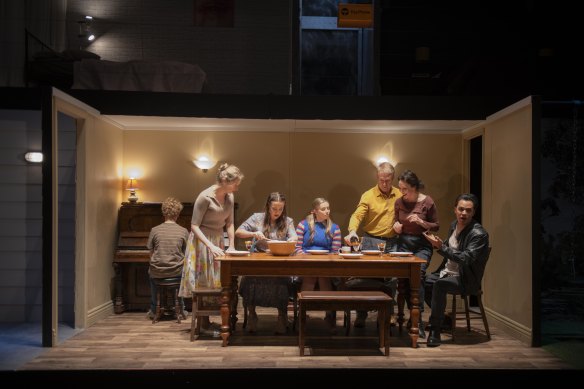
Kate Amos, Lucy Schneider, Chloe James, Michael Honeyman, Juel Riggall and Adrian Li Donni in The Children’s Bach.<\i>Credit: Jodie Hutchinson
First performed in 2008, this effective new production by Lyric Opera of Melbourne updates the story to the ’90s, where Dexter and Athena live with their autistic son, Billy, in Melbourne’s inner north. Dexter’s old flame Elizabeth and her current beau, Phillip, enter the fold, and Athena and Phillip begin a bruising affair. The title comes from an edition of sheet music, E. Harold Davies’ The Children’s Bach – from which Athena is learning – a collection of Bach piano pieces for beginners.
Andrew Schultz’s score is clever and evocative, and though it stands in Bach’s shadow, is obstinately original. The six-piece ensemble, led commendably by conductor Patrick Burns, produced a clean, tight performance, which is not so easily done when a score is such an enmeshing of musical styles.
As Athena, soprano Kate Amos is commanding. It’s not a likeable role but Amos imbues Athena with as much humanity as she can muster, while delivering a steely, confident vocal performance. Always-reliable baritone Michael Honeyman is in fine voice as Dexter, though Adrian Li Donni struggled with the hefty vocal demands of Phillip, which in turn affected his ability to convey the character’s required easy swagger.
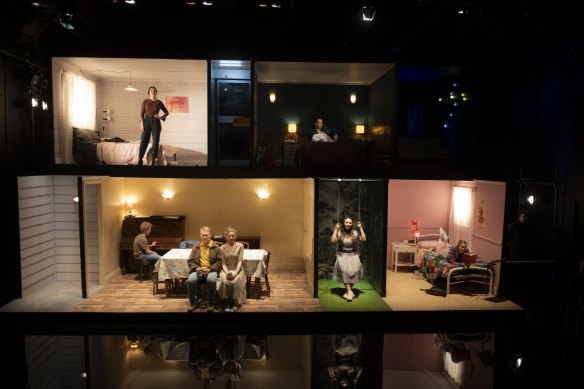
With a theme leaning so heavily on music, perhaps it’s not a surprise The Children’s Bach was adapted into an opera.Credit: Jodie Hutchinson
In Garner’s telling, the complexities of human relationships are laid bare through thoughtful prose. The characters’ inner beliefs on love, resentment and longing are seen through the prism of the protection (and limitation) of marriage. Without her nuance, we’re left with hollow hedonism, and no one to root for, save for the mute boy Billy.
In opera, we’re used to love and betrayal, but most of the time someone dies at the end, or they live ridiculously happily ever after. The drama is purposely unreal. Opera is not somewhere you go to see a mirror held up to life – the singing and heightened emotion need to match the medium.
On one hand, with a theme leaning so heavily on music, perhaps it’s not a surprise The Children’s Bach was adapted into an opera. On the other, the domesticity of the story itself might just be precisely what makes a celebrated book a rather ordinary opera.
Reviewed by Bridget Davies
MUSIC
Madison Beer | The Encore Tour ★★★
Margaret Court Arena, September 2
The crowd screams in delight as Madison Beer’s silhouette appears onstage in front of the blinding white screen.

Madison Beer performing at Margaret Court Arena on September 2.Credit: Richard Clifford
Melbourne is the final concert on the New York-born, 25-year-old singer’s debut Australian tour. Gaining fame at 13 years old when Justin Bieber shared her YouTube cover of Etta James’ At Last on Twitter, she’s since accumulated more than 2.4 billion global streams of her music.
Beer’s set, which starts 15 minutes late (potentially as a nod to her new single,15 Minutes) features tracks from 2023 album Silence Between Songs and 2021 album Life Support. Live guitar brings a rockier edge to her music.
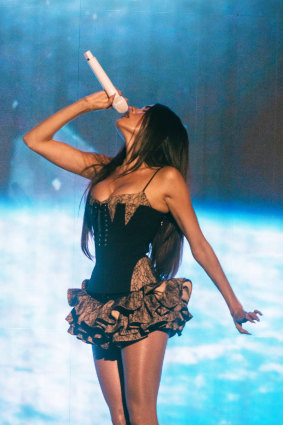
Madison Beer thrilled her fans.Credit: Richard Clifford
She starts off high energy, showing off her pop and R&B sensibility with Home To Another One, Good in Goodbye and Sweet Relief. After a long stretch of ballads and acoustic renditions, Make You Mine gets the crowd jumping again.
Beer has to restart songs twice to direct security to assist fainting fans. She’s earnest in her appreciation of her audience, exclaiming to the crowd: “What are you guys doing here? This is insane!” She cheekily flirts, handing out flowers during 17 and seductively parading across the stage during Baby.
Her vocal range is incredible and the audience cheers when she holds a particularly high note. TikTok followers in the know participate in the silence challenge during titular track Silence Between Songs.
It’s hard to pinpoint her sound. She channels Lana Del Rey during ballad Nothing Matters But You, while Showed Me (How I Fell In Love With You), sampling the Turtles’ You Showed Me, has a Tame Impala-esque psychedelic rock vibe.
A shorter show – it goes for almost 1½ hours – would have been punchier; despite this, the crowd maintains their fervour until the end.
As the show ends on King of Everything, the crowd light up the arena with their phone torches, and white confetti shoots out into the stadium. For diehard fans who wait around, Beer signs autographs after the stadium lights are turned back on – a moment they’re unlikely to forget.
Reviewed by Vyshnavee Wijekumar
DANCE
Horizon, Bangarra Dance Theatre ★★★★
Arts Centre Melbourne, until September 7
This triple bill of new works is a tour from horizon to horizon, from the islands of the Torres Strait to Lake Taupo in New Zealand, featuring commissions by Sani Townson, Deborah Brown and Maori artist Moss Te Ururangi Patterson.
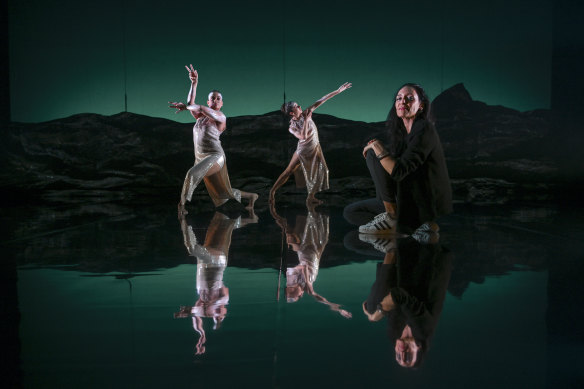
Choreographer Deborah Brown with dancers Amber Gordan, left, and Courtney Radford, right at a dress rehearsal ahead of Horizon. Credit: Eddie Jim
The evening begins with Kulka by Townson, a work reflecting on totem lore and the cultural heritage of Saibai Island. It has a busy, aerobic rhythm, with frequent group unison passages where simple lifts with trailing blue skirts recall rolling waves.
Townson’s choreography is complemented by – and sometimes in competition with – elaborate video designs projected onto the floor and reflected in a huge mirror. It’s a device that works best in the section dedicated to Koedalaw Awgadh, the crocodile god.
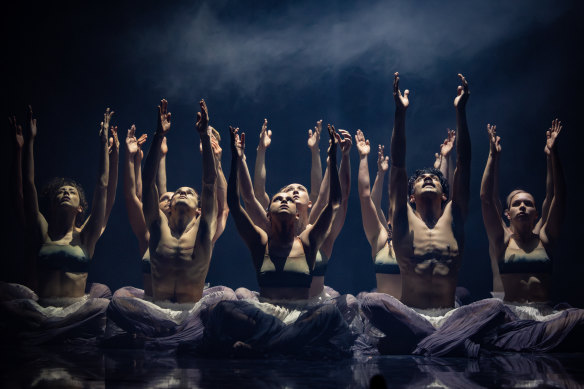
A scene from The Light Inside as part of Horizon.Credit: Daniel Boud
Brown also connects her piece, Salt Water, with the island culture of the Torres Strait. She focuses particularly on the western island of Badu and eastern island of Mer, from which she traces her ancestral lineage.
Like Townson’s piece, Salt Water has a steady, bustling energy. The highlight is its evocation of a submerged reef. Contorted bodies create an underwater vista, while small, jerky movements of the hands suggest the brittleness of coral skeletons.
The last section is a quicksilver solo by Lillian Banks in an eye-catching spangled costume designed by Jennifer Irwin: rapid pulsations in the arms and shoulders, bending and shifting, bring to mind the shimmer and flicker of a particularly bright star.
Moss Te Ururangi Patterson’s contribution, which takes inspiration from Maori spiritual traditions, is called Fresh Water: a companion piece to Brown’s Salt Water and part of a larger collaborative project called The Light Inside.
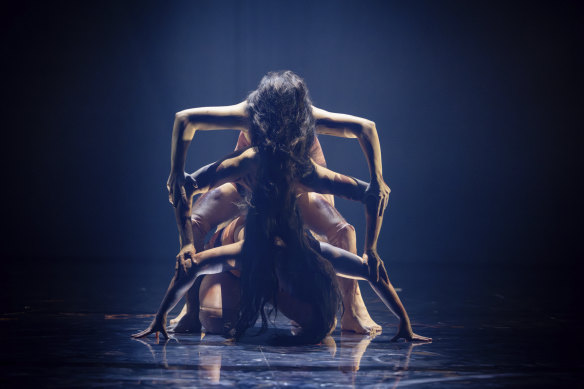
Emily Flannery, Jye Uren and Chantelle Lee Lockhart in a fable about magic hair.Credit: Daniel Boud
Patterson, who is the artistic director of New Zealand Dance Company, creates a number of special challenges for the Bangarra ensemble, placing a traditional haka in one of the sections and deploying forceful upper-body movements throughout.
Patterson’s choreography requires a level of concentration and intensity which the ensemble – with the notable exception of Kallum Goolagong – does not always achieve. And yet Fresh Water is still the most exciting of the three pieces because of its shadowy atmosphere and innovative use of tableaux.
The appearance of Emily Flannery, Chantelle Lee Lockhart and Jye Uren as sacred feminine presences in a representation of a fable about magic hair is particularly memorable.
While Horizon may not be as immersive or as consistently affecting as other Bangarra productions, as an expression of solidarity with the First Peoples of the Oceania region it nonetheless represents an important enlargement of the company’s core mission – and a new artistic frontier.
Reviewed by Andrew Fuhrmann
MUSIC
Orava Quartet ★★★★
Melbourne Recital Centre, August 30
Probably the closest thing Australian chamber music has to a boy band is the Brisbane-based Orava Quartet. Sporting their trademark colourful socks, violinists Daniel Kowalik and David Dalseno, violist Thomas Chawner and cellist Karol Kowalik continued their convincing advocacy of new Australian music by giving the world premiere of Paul Dean’s String Quartet No. 2.

Orava Quartet is probably the closest thing Australian chamber music has to a boy band.
Based on Edgar Allan Poe’s short poem A Dream Within A Dream, the work is cast in three movements. The first, labelled “fast, murky and troubled” opened with chimerical high strings pierced by shards of sound before projecting more cohesive yet turbulent textures.
Taking its name from Poe’s poem, the second movement came in four short scenes, one of which featured a heartfelt soliloquy from Chawner’s viola, followed by a reflective “prayer” in which the melding of the quartet’s mellow lower voices was particularly moving.
After working through references to the “pitiless wave” and the “roar” of Poe’s “surf-tormented shore”, the third movement “through my fingers to the deep” emerged as a meditation on the ephemeral nature of time and existence expressed in the poem, ending with short, soft breaths that confirmed the poet’s sentiments.
An effective and well-structured exploration of Poe’s theme, the music would have been given greater context had the poem been read beforehand.
Seemingly ablaze with bright Mediterranean sunlight, Claude Debussy’s deservedly popular String Quartet in G minor proved the perfect contrast to the shadowy realm of dreams. Apart from the luxuriously languorous third movement, the work thrummed with bustling energy. Gathering pace and driving towards its knife-edge finish, the finale became a visceral musical force that could only be generated by an ensemble that had developed a deep inner rapport.
A laid-back arrangement of a Danish folk melody sent the fans of this boy band home happy and satisfied.
Reviewed by Tony Way
MUSIC
Wuigada – Gagada (To Sing – Loud) | Now or Never Festival ★★★★
Kutcha Edwards and the Australian Art Orchestra, Capitol Theatre, Friday August 30
Wuigada – Gagada, the title of Kutcha Edwards’ collaboration with the Australian Art Orchestra, is a phrase in the Mutti Mutti language of Edwards’ ancestors – a language Edwards was forbidden from using after he was taken from his family as a child. Later in life, he reclaimed that language as part of his identity, and when he sings in Mutti Mutti, there’s a sense he is connecting with something intensely personal and profound.
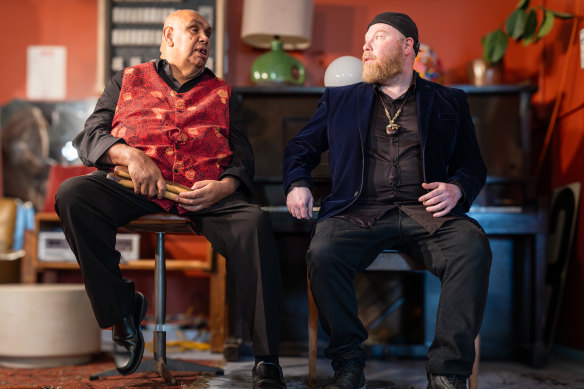
Kutcha Edwards with AAO artistic director Aaron Choulai.Credit: Ibukun Oloruntoba
Of course, his English-language lyrics can have an equally potent effect, as they did in Edwards’ superb concert with the Australian Art Orchestra on Friday night. Artistic director Aaron Choulai (on keyboards) and trumpeter-arranger Eugene Ball previously worked with Edwards in the Black Arm Band, and the singer was clearly delighted to be reuniting with them for this project.
Ball’s masterful arrangements, coupled with the band’s unerring sensitivity, underscored the poetry and pathos of Edwards’ songs.
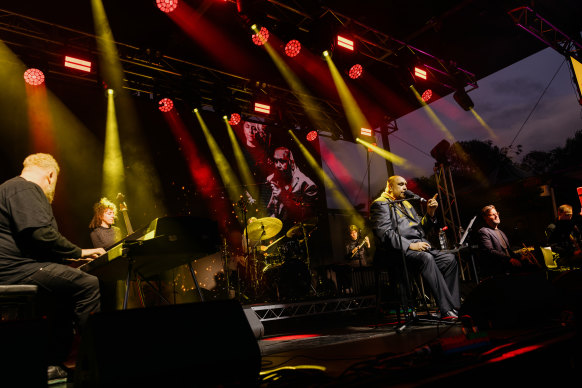
Kutcha Edwards performs with the AAO in Tasmania in early 2024.Credit: Moorilla Gallery
Unusual instrumental pairings (Rhodes and vibraphone; trumpet and contrabass recorder) and shifting dynamics created backdrops that ranged from spare and understated to dramatic and angular.
Singing Up Country opened in a field of rippling, rolling improvisation before settling into a languid shuffle. Mrs. Edwards (which recounts Edwards’ painful meeting with his birth mother after many years apart) featured a maelstrom of wailing electric guitar, mirroring Edwards’ inner turmoil as he recalled the “heartache and sorrow… so hard to ignore”.
For Mother Tongue, Edwards stood and sang in Mutti Mutti to each musician in turn – and then to us directly, from the front of the stage – in a gesture that was part blessing, part invocation.
The final song (Keep on Singing) evoked both sorrow and reassurance, Helen Svoboda’s arco bass wrapping tendrils around Edwards’ lyrics as his rich, supple voice trembled with emotion. The singer wiped away tears, and he wasn’t the only one. It made for a deeply moving end to a compelling, thought-provoking show.
Reviewed by Jessica Nicholas
MUSIC
Faure’s Requiem ★★★★
Melbourne Symphony Orchestra, Hamer Hall, August 29
The Melbourne Symphony Orchestra laid aside the managerial travails of the past fortnight, culminating in the departure this week of managing director Sophie Galaise, with a sumptuous performance of Gabriel Faure’s Requiem at Hamer Hall on Thursday.
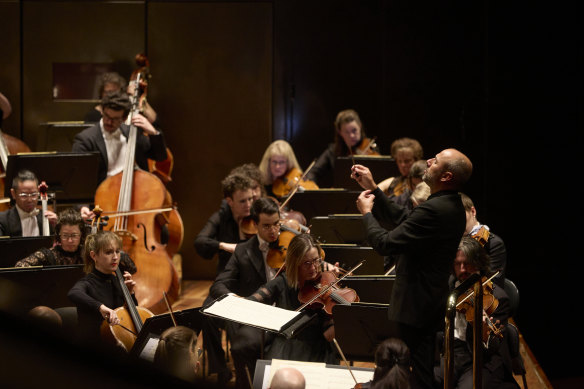
Conductor Lawrence Renes had clearly worked hard on balancing all the forces within orchestra and choir.Credit: Laura Manariti
Unlike Mozart’s dramatic Requiem or Verdi’s virtuosic, operatic version, Faure’s Requiem is sober, calm and serenely beautiful, and it received a deeply moving performance.
It is a great showcase for the excellent MSO Chorus in total command under Warren Trevelyan-Jones, while conductor Lawrence Renes had clearly worked hard on balancing all the forces within orchestra and choir.
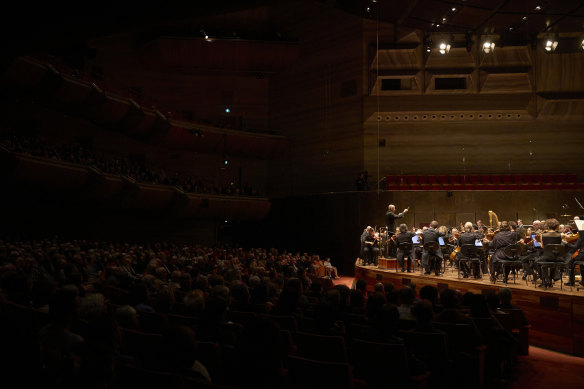
Unlike Mozart’s dramatic Requiem or Verdi’s operatic version, Faure’s Requiem is sober, calm and serenely beautiful.Credit: Laura Manariti
There are two soloists, soprano and baritone, but they sing for a total of about four minutes each, so it was luxury casting in the extreme to have Siobhan Stagg and Roderick Williams on stage.
Melbourne-raised Stagg, who is establishing a spectacular international career, sang Pie Jesu, the movement most often extracted from the work for recitals. Shut your eyes – or, indeed, open them – and it could have been an angel, such was her tender purity. Williams was sweet-toned and heroic.
The concert was marred, as it is whenever an organ is required, by the small “pop-up toaster” (valiantly played by Andrew Bainbridge) that is the only option, instead of the majestic built-in instrument an orchestra like the MSO and the city’s main concert hall demand. Arts Centre management removed the organ when the hall was refurbished a decade ago, and simply refuse to replace it.
An oddity for the Faure was an arrangement of the orchestra new to me: violas on the left, switching with the first violins, cellos in the middle, and double basses divided between the two wings. The reason, according to the MSO, is that the violins have a minor role in this work – there are two viola and two cello sections, but only one violin section. Principal violist Christopher Moore was thus concertmaster for this work.
Before the interval were Sibelius’ mysterious, elemental seventh symphony – his last, though he lived another 33 years – and Mythic by much-loved Australian composer Elena Kats-Chernin. Mythic, a subtle work of some substance, is described by the composer as “a kind of hymn with variations”. Scott Kinmont shone in the demanding trombone obbligato in the Sibelius, where Renes showed again his fine sense of shape and architecture.
Reviewed by Barney Zwartz
The Booklist is a weekly newsletter for book lovers from books editor Jason Steger. Get it every Friday.